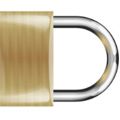Mill Safety - Lockout procedures save lives and equipment

Most mills have their own lock out and safety procedures posted throughout the mill. However, safety procedures, no matter how well intended, are not always followed.
Hopefully, mill personnel needn't wait for a lost-time accident to occur before practicing strict lock out procedures. Complete safety instructions and periodic refresher courses will help operating personnel understand the importance of these procedures.

DANGER:  |
Follow all lockout procedures established by the mill. Refer to the appropriate standards. For maintenance work, disconnect all devices from electric power sources. Bring all hydraulic, pneumatic, gravity, or spring loaded devices to a zero-energy state. Follow lockout procedures. The lockout program, locks, tags and the blocking/restraining devices provided are designed for your protection. Your responsibility is to follow the program and use the proper equipment. REMEMBER: Work to eliminate injury and death. Follow proper procedures at all times! |

Lockout guidelines
Following lockout procedures is not only a good idea, it's the law. For the United States, the relevant statute is the Occupational Safety and Health Administration (OSHA) under Section 1910.261(b)(1), which states:
For Canada, the Occupational Health and Safety (OH&S) CSA Z460-13 is the relevant guiding statute.
Lock out procedures on all controls are extremely important when a worker must enter a tank, chest, barking drum, dryer cylinder or other potentially hazardous area.
Although varied, each mill's set of lock out procedures should comply with state/province and OSHA/OH&S regulations.
Lockout recommendations
The following recommended procedures can help prevent personal injury and/or machine damage:
- Notify the operating supervisor or operator of the equipment or section that has to be shut down and locked out.
- With an electrical power source, an electrician, usually the one responsible for the equipment, must be notified to open a disconnect.
- Once the electrician opens the disconnect, the circuit must be tested with a meter to make sure the current is broken and the disconnect switch is locked out.
- A group supervisor and/or individual worker must then apply a lock to the disconnect or switch box. Many mills have set up color codes for locks and provide them from a central source. In other cases, workers may have their own locks identified by color, name, photograph, clock number or a combination of these. Each employee working on the machine is required to put a personalized lock on the switch. There area variety of devices that permit multiple locks to be placed on a single disconnect or switch.
- A worker applying the lock must have the electrician test the circuit to confirm the identification of the circuit that has been taken out of service.
- Where the electrical disconnects may be hazardous, an electrician may apply or remove the lock for a non-electrical worker, but only while the worker is present.
- Each worker is responsible for their own lock. Each person performing maintenance work should install their own lock and sign the lockout tag.
- Ensure that during lockout procedures, locks and signs are appropriately attached, and subsequently removed only by the person who installed them after all work is completed.
- When working on devices powered by hydraulics, gas, air or steam, the control levers, electrical power to the pump motors and valves must be locked out to prevent the equipment from being started. Raised components must be mechanically blocked. All employees working on this type of equipment must attach their locks to the device before working on it.
- When the work is finished, the last person to remove their lock must inform the operating supervisor or operator that the equipment is ready to put back in service.
- A warning blast and a final blast should be given before starting up large equipment again.
On major shutdowns, such as clothing exchange, i.e., wires, felts, or dry felts, it is recommended that a senior shift supervisor lock out the equipment involved.

IMPORTANT:  |
If unsure of any procedure, check the operation manuals Follow all lockout and safety procedures before entering the Be constantly aware of the location of each worker on the Observe all safety instructions. Do not remove or disable any installed safety device, sign or Do not compromise safety due to time pressures! |

Lock out procedures and mill safety rules are not optional – employees must always follow them. If an employee is not familiar with these procedures and finds himself or herself in a position where equipment must be locked out, they must ask their supervisor for the correct procedures – more than a job depends on it.
For more information in improving safety at your mill, including equipment safety upgrades and training, contact your Valmet representative.